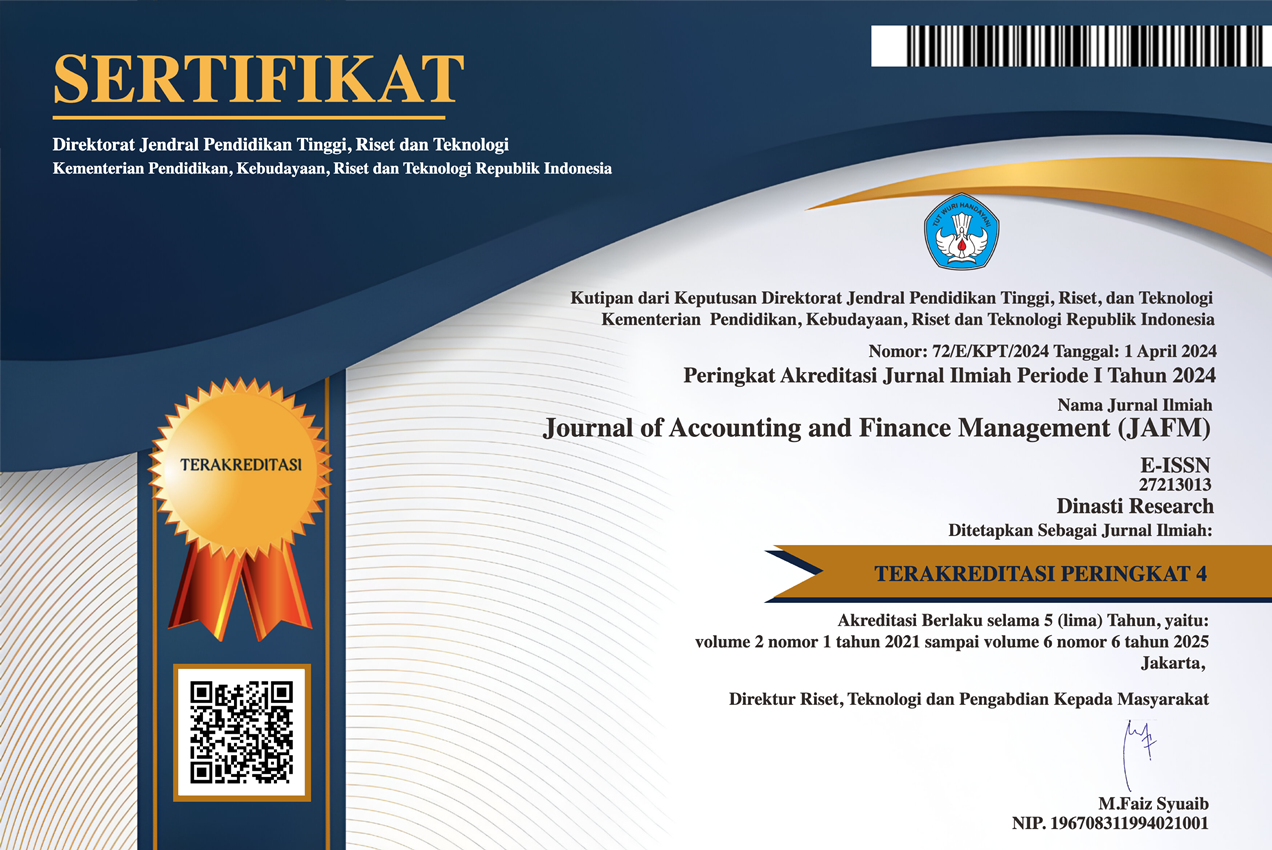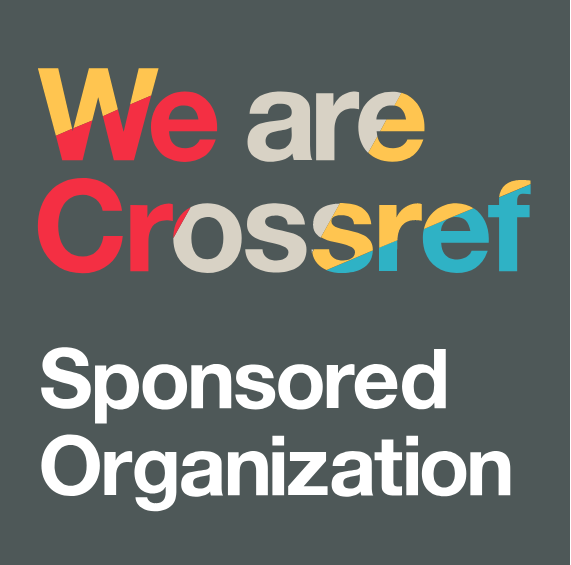Analysis of Digital Transformation Strategies and Product Innovation to Enhance Competitive Advantage in Fisheries MSMEs to Support the Blue Economy in Kendal Regency
DOI:
https://doi.org/10.38035/jafm.v6i3.2209Keywords:
Digital Transformation, Product Innovation, Competitive Advantage, Blue EconomyAbstract
This study aims to analyze the influence of digital transformation and product innovation on the competitive advantage of fish processing MSMEs in Kendal Regency to support the Blue Economy. Kendal has significant potential in aquaculture, particularly milkfish, but faces challenges such as marketing, technology adoption, and business management. A deductive approach with a survey method was employed to collect primary data through questionnaires distributed to 278 MSME actors. Data analysis was conducted using Structural Equation Modeling (SEM) based on Partial Least Square (PLS). The results indicate that product innovation significantly influences competitive advantage with a coefficient of 0.831 (p < 0.05), and digital transformation also has a significant influence with a coefficient of 0.060 (p < 0.05). Together, product innovation and digital transformation explain 74.6% of the variability in competitive advantage. Therefore, it is recommended that MSMEs enhance their product innovation capacity through diversification and added value development, as well as leverage digital transformation using e-commerce platforms and social media to expand market access. This study contributes to the development of strategies for Kendal’s fishery MSMEs to support the Blue Economy and achieve sustainable competitive advantage.
References
Aspara, J., Lamberg, J. A., Laukia, A., & Tikkanen, H. (2013). Corporate business model transformation and inter-organizational cognition: The case of Nokia. Long Range Planning, 46(5–6), 459–474. https://doi.org/10.1016/j.lrp.2011.06.001
Chatzoglou, P., & Chatzoudes, D. (2018). The role of innovation in building competitive advantages: An empirical investigation. European Journal of Innovation Management, 21(1), 44–69. https://doi.org/10.1108/EJIM-02-2017-0015
Dahmiri, D., Bhayangkari, S. K. W., & Khalik, I. (2021). Pengaruh kualitas produk dan inovasi terhadap keunggulan bersaing UMKM kuliner di masa pandemi Covid-19. Ekonomis: Journal of Economics and Business, 5(2), 434. https://doi.org/10.33087/ekonomis.v5i2.401
Direktur Jenderal Penguatan Daya Saing Produk Kelautan dan Perikanan (PDSPKP). (n.d.). Pentingnya Usaha Mikro Kecil dan Menengah (UMKM). Retrieved March 27, 2024, from https://www.kkp.go.id/search.html
Hamzah, F., & Ariesta, F. (2022). Pengaruh kualitas dan inovasi produk terhadap kepuasan konsumen di Kuswini Catering Bandung. Jurnal Sains Manajemen, 4(1), 26–35. https://doi.org/10.51977/jsm.v4i1.694
Indriastuti, M., Mutamimah, & Riansyah, A. (2023). Pelatihan dan pendampingan pengembangan inovasi dan packaging produk ikan asap Kec. Rowosari, Kab. Kendal. Indonesian Journal of Community Services, 5(1), 65. https://doi.org/10.30659/ijocs.5.1.65-74
KADIN Indonesia. (n.d.). Ekonomi Biru - Kadin Indonesia. Retrieved March 27, 2024, from https://kadin.id/en/program/ekonomi-biru/
Karolina, A., Anggoro, S., & Supriharyono, S. (2020). Profil osmotik gelondongan ikan bandeng (Chanos chanosForsskal) selama proses kultivasi di tambak bandeng Desa Wonorejo Kabupaten Kendal. Jurnal Perikanan Tropis, 7(2), 145. https://doi.org/10.35308/jpt.v7i2.2568
Prayuda, R. (2020). Strategi pengembangan konsep blue economy dalam pemberdayaan masyarakat di wilayah pesisir. Indonesian Journal of International Relations, 3(2), 46–64. https://doi.org/10.32787/ijir.v3i2.90
Qur’ani, B., & Anshar, M. A. (2023). Analisis faktor-faktor pengembangan UMKM dengan transformasi digital dalam pertahanan ekonomi pasca Covid-19. JEMMA (Journal of Economic, Management and Accounting, 6(1), 12. https://doi.org/10.35914/jemma.v6i1.1603
Sadri, M., Darsih, T. K., Putra, A. N., & Hasanah, N. (2023). Transformasi ekonomi digital berbasis blue economy pada usaha kecil kelompok usaha pengolahan ikan asin di Desa Jaring Halus Kecamatan Secanggang Kabupaten Langkat. Jurnal Pengabdian Kepada Masyarakat, 4(2), 28–41.
Schwertner, K. (2017). Digital transformation of business. Trakia Journal of Sciences, 15(1), 388–393. https://doi.org/10.15547/tjs.2017.s.01.065
Sulaiman, E., Handayani, C., & Widyastuti, S. (2021). Transformasi digital technology-organization-environment (TOE) dan inovasi difusi e-business untuk UMKM yang berkelanjutan: Model konseptual. Jurnal Manajemen & Bisnis Kreatif, 7(1), 51–62.
Utami, K., & Prasetyo, A. D. (2024). Transformasi digital: Meningkatkan daya saing UMKM melalui proses digitalisasi (sosialisasi pada UMKM wilayah Desa Tamansari). Capacitarea: Jurnal Pengabdian kepada Masyarakat, 3(3), 77–83. https://doi.org/10.35814/capacitarea.2023.003.03.11
Wiwoho, G. (2019). Orientasi pasar dan inovasi produk, serta pengaruhnya terhadap keunggulan bersaing dan kinerja perusahaan pada UMKM: Sebuah agenda penelitian. Fokus Bisnis: Media Pengkajian Manajemen dan Akuntansi, 18(2), 29–38. https://doi.org/10.32639
Wroblewski, J. (2018). Digitalization and firm performance: Are digitally mature firms outperforming their peers? Retrieved from https://lup.lub.lu.se
Xue, F., Zhao, X., & Tan, Y. (2022). Digital transformation of manufacturing enterprises: An empirical study on the relationships between digital transformation, boundary spanning, and sustainable competitive advantage. Discrete Dynamics in Nature and Society, 2022, 1–16.https://doi.org/10.1155/2022/1182987
Xue, F., Tan, Y., & Anwar, S. (2024). Innovation strategy, digital transformation and competitive advantage of manufacturing enterprises: Evidence from China. European Journal of Innovation Management. https://doi.org/10.1108/EJIM-09-2023-0786
Yanti, D., & Astuti, M. (2023). Orientasi pasar dan inovasi produk terhadap keunggulan bersaing (pada produk mie instan Lemonilo). Jurnal Ilmiah Metansi (Manajemen dan Akuntansi), 6(2), 151–161. https://doi.org/10.57093/metansi.v6i2.201
Downloads
Published
How to Cite
Issue
Section
License
Copyright (c) 2025 Ali Ridho, Dwi Rachmawati

This work is licensed under a Creative Commons Attribution 4.0 International License.
Authors who publish their manuscripts in this journal agree to the following conditions:
- The copyright on each article belongs to the author(s).
- The author acknowledges that the Journal of Accounting and Finance Management (JAFM) has the right to be the first to publish with a Creative Commons Attribution 4.0 International license (Attribution 4.0 International (CC BY 4.0).
- Authors can submit articles separately, arrange for the non-exclusive distribution of manuscripts that have been published in this journal into other versions (e.g., sent to the author's institutional repository, publication into books, etc.), by acknowledging that the manuscript has been published for the first time in the Journal of Accounting and Finance Management (JAFM).
























